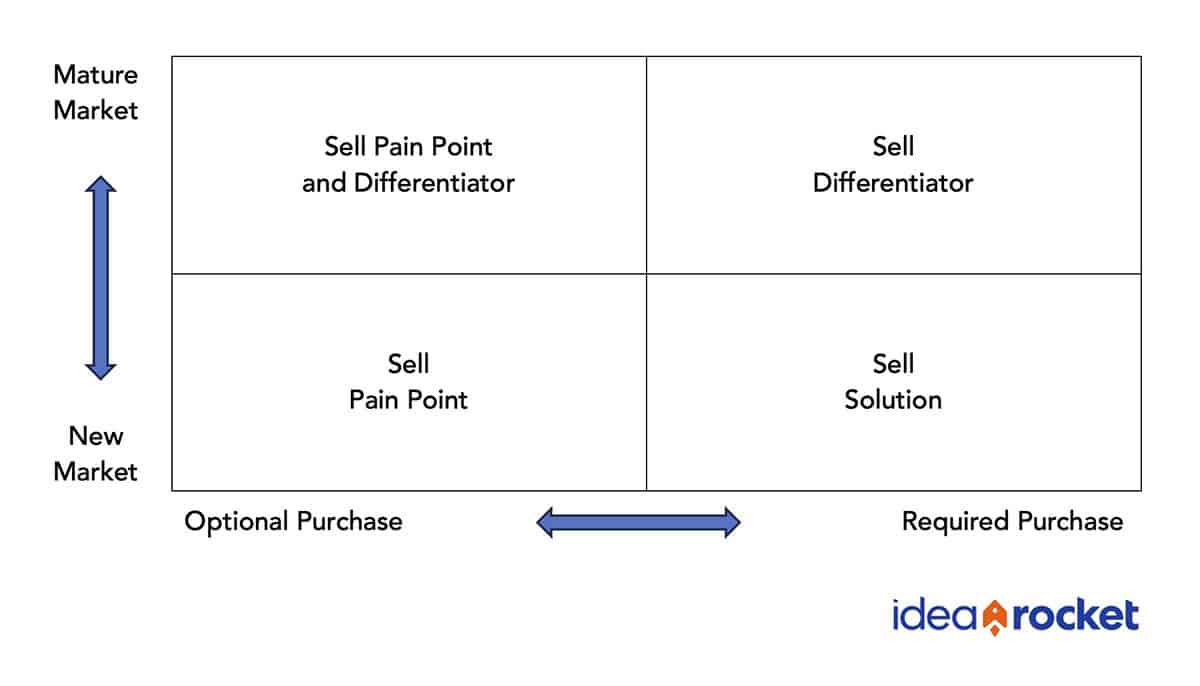A seemingly straightforward question has plagued marketers since the dawn of time: should you focus on the problem or the solution? Some will tell you to focus on the client, which means you sell the problem, not the solution. Others insist that customers know their own pain points, what they need to understand is why your product is special.
As with many marketing questions, the best answer comes down to context. In a mature market, for a product customers know they need, you can focus on differentiators. For required purchases in a new market, you can focus on selling the solution.
The graphic below lays out the four contexts your marketing might face. You just need to figure out which one you’re working in. Let’s take a closer look at each.

Mature Market/Optional: Sell Everything
If your market is mature and the purchase is optional, there are no shortcuts. You have to convince viewers both that they need your product and that yours is the best solution. Most financial services and FinTech offerings fall into this category.
That means you have to fit a lot into a short video. Most brands start by outlining the problem. They pick a specific pain point to highlight. Then they show how their solution uniquely solves that pain point.
Mature Market/Required Purchase: Sell the Differentiator
Customers need what you’re selling so they can meet regulatory standards or keep lives and business running. The problem is that many other brands offer similar solutions.
“When you’re in a mature market with lots of competitors,you have to pinpoint what it is that makes your solution better than the others in the market,” says IdeaRocket founder and Creative Director, Will Gadea.
In a mature, saturated market, you always want to lead with your strongest differentiators. That means actually focusing on the specifics of your solution.
- What do you do better than anyone else?
- What’s the competition doing wrong?
- What makes your business proposition unique?
Selling the solution takes many forms. You might highlight technological advances, superior service or a unique business model..
For example, Scandis, a furniture company in a highly competitive landscape, differentiated themselves not by talking about the quality of their furniture, but by explaining how customer’s benefit from the way Scandis does business.
New Market/Optional Purchase: Sell the Problem You Solve
On the rare occasion that you can offer a truly novel solution, the best tactic is a counterintuitive approach. Sell the problem you solve, not the solution.
“Since your product is creating a new market, you don’t have to worry about differentiation,” Gadea said.
According to VC David Bailey, the key to selling the problem is to “bring the message to life, using concrete and specific language and vivid metaphors.” Nothing makes a metaphor more vivid than video.
This explainer video for ShowerStart Express focuses on the time wasted waiting for a shower to get hot. It’s a problem many people haven’t thought about, until they watch the video below.
New Market/Required Purchase: Sell the Solution
The new market/required scenario most likely grows out of new regulations. Customers in this context may have high anxiety. They need what you’re selling, but they also need to know that yours is the right solution.
Taking an educational approach can help soothe buyer fears. Give them plenty of information about the situation and your solution. Let them know they’re safe with you.
Find Your Position in the Market
The contexts mentioned above don’t always have clear boundaries. They meld into each other as markets shift. Your solution may well fall somewhere in the middle, and that’s okay.
The right approach comes from taking the perspective of your customers. Think about what they already know, and what they’re worried about. Skip information they already have and jump straight to what they need to know to make a purchase with confidence.
To find out more about how you can succeed with animated video, download our free eBook and sign up for our monthly newsletter. It’s packed with tips, success stories, and video marketing news.



